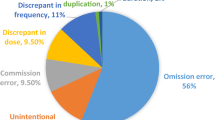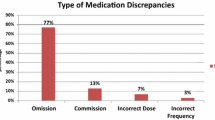Abstract
Background Medication reconciliation at admission to hospital reduces the prevalence of medication errors. Strategies are needed to ensure timely and efficient delivery of this service. Objective To investigate the effect of aligning clinical pharmacy services with consultant teams, by pharmacists attending post-admission ward rounds, in comparison to a ward-based service, on prevalence of unintentional unresolved discrepancies 48 h into admission. Setting A 243-bed public university teaching hospital in Ireland. Method A prospective, uncontrolled before-after observational study. A gold standard preadmission medication list was completed for each patient and compared with the patient’s admission medication prescription and discrepancies were noted. Unresolved discrepancies were examined at 48 h after admission to determine if they were intentional or unintentional. Main outcome measured Number of patients with one or more unintentional, unresolved discrepancy 48 h into admission. Results Data were collected for 140 patients, of whom 73.5% were over 65 years of age. There were no differences between before (ward-aligned) and after (team-aligned) groups regarding age, number of medications or comorbidities. There was a statistically significant reduction in the prevalence of unintentional, unresolved discrepancy(s) per patient (67.3 vs. 27.3%, p < 0.001) and per medication (13.7 vs. 4.1%, p < 0.001) between the groups, favouring the team-based service. The effect remained statistically significant having adjusted for patient age, number of medications and comorbidities (adjusted odds ratio 4.9, 95% confidence interval 2.3–10.6). Conclusion A consultant team-based clinical pharmacy service contributed positively to medication reconciliation at admission, reducing the prevalence of unintentional, unresolved discrepancy(s) present 48 h after admission.


Similar content being viewed by others
References
Belda-Rustarazo S, Cantero-Hinojosa J, Salmeron-García A, González-García L, Cabeza-Barrera J, Galvez J. Medication reconciliation at admission and discharge: an analysis of prevalence and associated risk factors. Int J Clin Pract. 2015;69:1268–74.
O’Riordan C, Delaney T, Grimes T. Exploring discharge prescribing errors and their propagation post-discharge: an observational study. Int J Clin Pharm. 2016;38:1172–81.
Rodríguez Vargas B, Delgado Silveira E, Iglesias Peinado I, Bermejo Vicedo T. Prevalence and risk factors for medication reconciliation errors during hospital admission in elderly patients. Int J Clin Pharm. 2016;38:1164–71.
Gallagher J, Byrne S, Woods N, Lynch D, McCarthy S. Cost-outcome description of clinical pharmacist interventions in a university teaching hospital. BMC Health Serv Res. 2014;14:1.
Mekonnen AB, McLachlan AJ, Brien J-aE. Effectiveness of pharmacist-led medication reconciliation programmes on clinical outcomes at hospital transitions: a systematic review and meta-analysis. BMJ Open. 2016;6(2):e010003. doi: 10.1136/bmjopen-2015-010003.
Mueller SK, Sponsler KC, Kripalani S, Schnipper JL. Hospital-based medication reconciliation practices: a systematic review. Arch Int Med. 2012;172:1057–69.
Fernandes O, Shojania KG. Medication reconciliation in the hospital: what, why, where, when, who and how. Healthc Q. 2012;15:42–9.
Galvin M, Jago-Byrne MC, Fitzsimons M, Grimes T. Clinical pharmacist’s contribution to medication reconciliation on admission to hospital in Ireland. Int J Clin Pharm. 2013;35:14–21.
Kripalani S. Clinical summaries for hospitalised patients: time for higher standards. BMJ Qual Saf. 2016. doi:10.1136/bmjqs-2016-005826.
Sarzynski E, Hashmi H, Subramanian J, Fitzpatrick L, Polverento M, Simmons M, et al. Opportunities to improve clinical summaries for patients at hospital discharge. BMJ Qual Saf. 2016. doi:10.1136/bmjqs-2015-005201.
Doucette WR, Nevins J, McDonough RP. Factors affecting collaborative care between pharmacists and physicians. Res Soc Admin Pharm. 2005;1:565–78.
Snyder ME, Zillich AJ, Primack BA, Rice KR, McGivney MAS, Pringle JL, et al. Exploring successful community pharmacist–physician collaborative working relationships using mixed methods. Res Soc Admin Pharm. 2010;6:307–23.
Bardet J-D, Vo T-H, Bedouch P, Allenet B. Physicians and community pharmacists collaboration in primary care: a review of specific models. Res Soc Admin Pharm. 2015;11:602–22.
Grimes TC, Deasy E, Allen A, O’Byrne J, Delaney T, Barragry J, et al. Collaborative pharmaceutical care in an Irish hospital: uncontrolled before-after study. BMJ Qual Saf. 2014;23:574–83.
Khalil V, deClifford JM, Lam S, Subramaniam A. Implementation and evaluation of a collaborative clinical pharmacist’s medications reconciliation and charting service for admitted medical inpatients in a metropolitan hospital. J Clin Pharm Ther. 2016;41:662–6.
Tong EY, Roman CP, Newnham H, Galbraith K, Dooley MJ. Partnered medication review and charting between the pharmacist and medical officer in the Emergency Short Stay and General Medicine Unit. Australas Emerg Nurs J. 2015;18:149–55.
Miller G, Franklin BD, Jacklin A. Including pharmacists on consultant-led ward rounds: a prospective non-randomised controlled trial. Clin Med. 2011;11:312–6.
Walton V, Hogden A, Johnson J, Greenfield D. Ward rounds, participants, roles and perceptions: literature review. Int J Health Care Qual Assur. 2016;29:364–79.
Dean BS, Barber ND. A validated, reliable method of scoring the severity of medication errors. Am J Health-Syst Pharm. 1999;56:57–62.
van den Bemt PM, van der Schrieck-de Loos EM, van der Linden C, Theeuwes AM, Pol AG. Effect of medication reconciliation on unintentional medication discrepancies in acute hospital admissions of elderly adults: a multicenter study. J Am Geriatr Soc. 2013;61:1262–8.
Buckley MS, Harinstein LM, Clark KB, Smithburger PL, Eckhardt DJ, Alexander E, et al. Impact of a clinical pharmacy admission medication reconciliation program on medication errors in “high-risk” patients. Ann Pharmacother. 2013;47:1599–610.
Quélennec B, Beretz L, Paya D, Blicklé JF, Gourieux B, Andrès E, et al. Potential clinical impact of medication discrepancies at hospital admission. Eur J Int Med. 2013;24:530–5.
Zoni AC, Duran Garcia ME, Jimenez Munoz AB, Salomon Perez R, Martin P, Herranz Alonso A. The impact of medication reconciliation program at admission in an internal medicine department. Eur J Int Med. 2012;23:696–700.
Tallon M, Barragry J, Allen A, Breslin N, Deasy E, Moloney E, et al. Impact of the collaborative pharmaceutical care at Tallaght Hospital (PACT) model on medication appropriateness of older patients. Eur J Hosp Pharm. 2015. doi:10.1136/ejhpharm-2014-000511.
Eccles M, Grimshaw J, Campbell M, Ramsay C. Research designs for studies evaluating the effectiveness of change and improvement strategies. Qual Saf Health Care. 2003;12:47–52.
Acknowledgements
We acknowledge the input of the doctors and pharmacists who supported the clinical significance grading of discrepancies.
Funding
None.
Author information
Authors and Affiliations
Corresponding author
Ethics declarations
Conflicts of interest
None.
Rights and permissions
About this article
Cite this article
Byrne, S.M., Grimes, T.C., Jago-Byrne, MC. et al. Impact of team-versus ward-aligned clinical pharmacy on unintentional medication discrepancies at admission. Int J Clin Pharm 39, 148–155 (2017). https://doi.org/10.1007/s11096-016-0412-4
Received:
Accepted:
Published:
Issue Date:
DOI: https://doi.org/10.1007/s11096-016-0412-4




